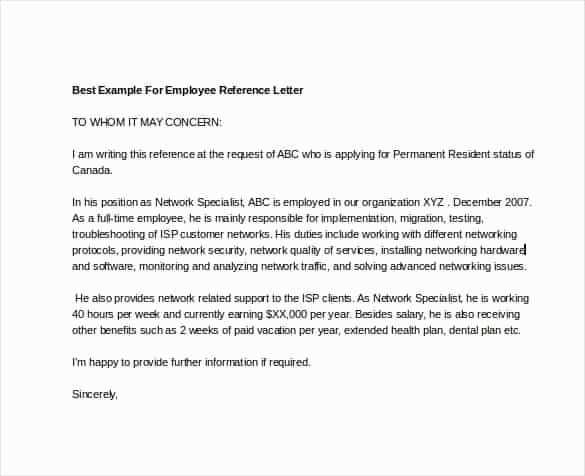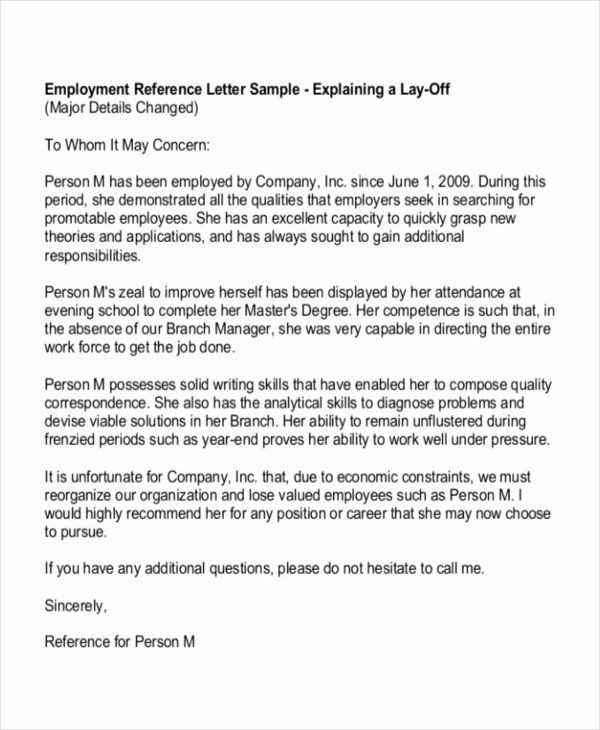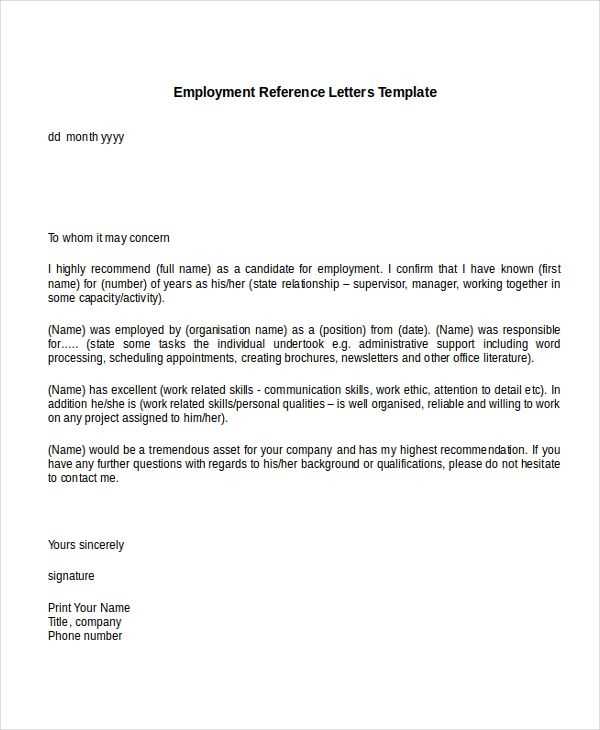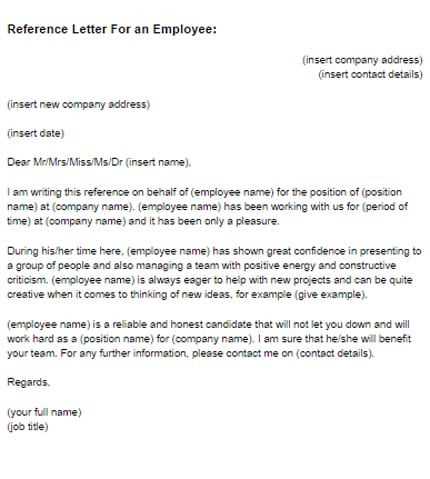Template for Letter of Reference for Employment

When it comes to securing a job or advancing in one’s career, a strong endorsement from a trusted individual can make all the difference. An effective recommendation can highlight an individual’s strengths and work ethic, providing valuable insights to potential employers. A well-structured message of support serves as proof of qualifications and character, often playing a crucial role in the hiring process.
Creating such a document requires careful attention to detail. The structure should clearly convey the necessary information while remaining professional and concise. Whether you are the one preparing this document or requesting it, understanding the essential components will ensure its effectiveness. By following a simple guide, anyone can produce a compelling and impactful statement of support.
Understanding the Importance of Reference Letters

In many career paths, individuals are often asked to provide proof of their qualifications, work ethic, and character. One of the most effective ways to do this is through an endorsement from someone who has directly worked with or observed the individual in a professional setting. Such testimonials offer employers a glimpse into the applicant’s skills, personality, and reliability, giving them more confidence in their hiring decision.
Building Trust and Credibility
One of the main reasons why endorsements are so valuable is because they build trust. Having a respected person vouch for your abilities can make a significant difference in how employers perceive you. A strong statement of support can convince a potential employer that you are not only capable but also dependable and trustworthy.
Highlighting Key Qualities and Skills
Endorsements also serve to highlight specific qualities and skills that might not be immediately evident from a resume. While resumes list accomplishments and qualifications, a well-written recommendation offers a deeper look at how an individual performs in real-world situations. It can emphasize key strengths, such as teamwork, problem-solving, leadership, and communication skills, which are critical to success in any role.
| Key Factors Highlighted | How They Benefit the Applicant |
|---|---|
| Work Ethic | Shows reliability and dedication to tasks |
| Communication Skills | Indicates ability to work effectively with others |
| Leadership | Demonstrates initiative and responsibility |
| Problem-Solving | Highlights creative and analytical thinking abilities |
In summary, receiving a well-crafted endorsement is an invaluable asset. It can set you apart from other candidates and give employers the confidence they need to move forward with your application. Understanding the importance of such documents helps both those requesting and writing them to create more meaningful and impactful statements of support.
Key Elements to Include in Your Template

Creating an effective endorsement requires careful consideration of the key details that should be included to convey the most relevant and impactful information. The content should be structured in a way that highlights the individual’s strengths, qualifications, and character, providing clear evidence of their ability to succeed in the role they are applying for. A well-crafted document will not only offer an honest evaluation but also reinforce the individual’s value to potential employers.
Introduction and Purpose
The opening section should clearly state the purpose of the endorsement and the relationship between the writer and the individual. It’s important to mention how long the person has been known and in what capacity. A strong introduction sets the tone and gives context to the reader, making the recommendation more credible.
Specific Skills and Achievements
Next, it’s essential to focus on the individual’s key strengths and accomplishments. This can include notable achievements, relevant skills, and specific examples that demonstrate their abilities. Emphasize qualities that are directly related to the role they are applying for, such as leadership, teamwork, or problem-solving skills. Including measurable achievements, when possible, adds more weight to the endorsement.
Example: “During the time I worked with John, he consistently exceeded sales targets, achieving 120% of his goal every quarter.” This gives a clear, tangible example of performance and makes the endorsement more credible and specific.
Including details that are both professional and personal can make the statement more relatable and impactful. Demonstrating that the individual has a strong work ethic, a positive attitude, and the ability to work well with others can be just as important as technical skills.
How to Customize a Reference Letter
When crafting a personalized endorsement, it is crucial to tailor the content to fit the specific individual and the position they are seeking. A generic statement will not have the same impact as one that highlights unique qualities and accomplishments. By adjusting the language and focus of the message, you can ensure that the endorsement resonates with the reader and effectively supports the applicant’s goals.
Adjusting the Tone and Content
The tone of the endorsement should reflect both the individual’s personality and the professional setting they are applying to. For example, a candidate seeking a creative role may benefit from a more dynamic and expressive endorsement, whereas someone applying for a corporate position might require a more formal and direct approach. Tailoring the content means emphasizing qualities that align with the job, such as creativity, leadership, or technical expertise.
Incorporating Specific Achievements and Skills
Customizing the content also involves providing specific examples that showcase the candidate’s skills and past accomplishments. Instead of general statements like “John is a hard worker,” include details such as “John consistently met tight deadlines and played a key role in launching a successful marketing campaign.” These concrete examples highlight the applicant’s value and demonstrate how they can contribute to the potential employer’s needs.
Tips for Writing a Professional Recommendation
When writing a strong professional endorsement, it is essential to focus on clarity, precision, and relevance. A well-structured message should effectively convey the applicant’s qualifications, work ethic, and character, providing the employer with enough information to make an informed decision. Here are several tips to help ensure the recommendation is both professional and impactful.
- Be specific: Use concrete examples to illustrate the individual’s strengths and accomplishments. Highlight their contributions with real-world results that demonstrate their skills.
- Keep it concise: While it’s important to provide relevant details, avoid unnecessary information. A recommendation should be clear and to the point, not overly long.
- Focus on the role: Tailor the content to the position the applicant is seeking. Mention skills and experiences that are directly relevant to the job, such as leadership, problem-solving, or technical expertise.
- Maintain a positive tone: The recommendation should focus on the individual’s strengths and qualities that make them a good fit for the role. Be honest but highlight their best attributes.
- Proofread: Ensure the final endorsement is free of errors. Check for spelling, grammar, and punctuation mistakes to maintain professionalism.
By following these tips, you can create a well-rounded and effective recommendation that will stand out to potential employers.
Common Mistakes to Avoid in Letters
When drafting a professional recommendation, it’s important to avoid common pitfalls that could undermine the message or reduce its impact. These errors can weaken the applicant’s chances or make the endorsement less convincing. Here are some frequent mistakes to watch out for when crafting your message.
- Being too vague: General statements such as “John is a good worker” don’t provide enough evidence of the individual’s capabilities. Always include specific examples to demonstrate the applicant’s strengths and accomplishments.
- Overuse of clichés: Avoid overused phrases like “hard worker” or “team player” without context. These expressions can come across as insincere or unoriginal if not backed by tangible proof.
- Making the endorsement too long: Lengthy recommendations can become tedious for the reader. Focus on the most important points and keep the content concise and impactful.
- Using overly casual language: While the tone should be positive, a professional endorsement should maintain a formal tone. Avoid slang or overly informal language that could diminish the credibility of the message.
- Including irrelevant information: Stick to details that are directly related to the individual’s qualifications and the position they are applying for. Avoid including personal anecdotes or unrelated accomplishments.
- Failure to proofread: Errors in grammar, spelling, or punctuation can harm the professionalism of the recommendation. Always review the content carefully before sending it out.
By staying mindful of these common mistakes, you can ensure that your endorsement remains clear, effective, and professional.
When to Use a Reference Letter Template

There are times when utilizing a pre-structured format can significantly ease the process of drafting a professional endorsement. By having a framework to follow, you can ensure consistency and focus on the essential aspects without overlooking important details. This approach can save time while still creating a document that is both meaningful and effective.
A ready-made structure can be particularly useful when you are writing multiple endorsements or need to adhere to a specific format. Additionally, it is beneficial when you lack the experience or confidence in composing such documents, as it provides a clear direction to guide your writing. However, even when using such a framework, it is important to personalize the content to reflect the unique qualities and achievements of the individual being recommended.